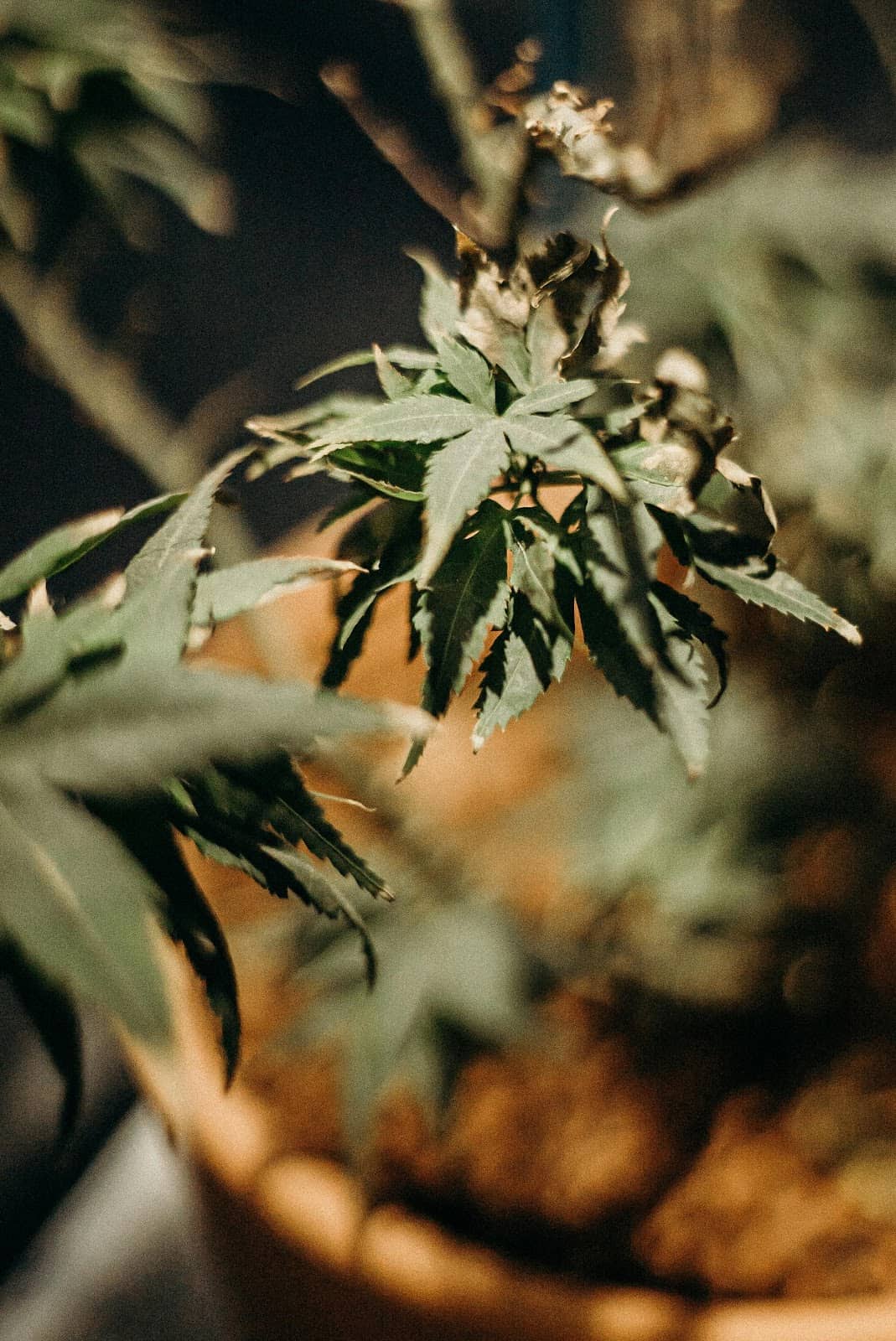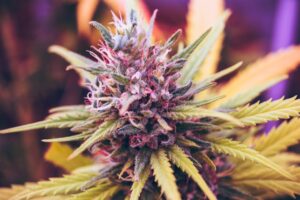Understanding how nutrient burn affects your cannabis plant essential for optimizing plant growth. Overfeeding cannabis plants causes nutrient burn, which damages leaves and slows growth. This common condition can be prevented or managed with proper education and care.
Recognizing nutrient burn in your cannabis garden will assist prevent further harm. Knowing the causes, symptoms, and solutions is essential for maintaining the health and yield of your plants. By managing nutrient levels carefully, you can help your cannabis thrive.
Key Takeaways
- Detecting nutrient burn symptoms early can prevent further damage.
- Proper nutrient management is key to healthy cannabis growth.
- Correcting nutrient burn can restore your plants to optimal health.
Understanding Nutrient Burn
Nutrient burn occurs when cannabis plants receive too many nutrients, usually due to excess fertilizer use. Your plants may exhibit several symptoms due to this excess.
Common Symptoms of Nutrient Burn
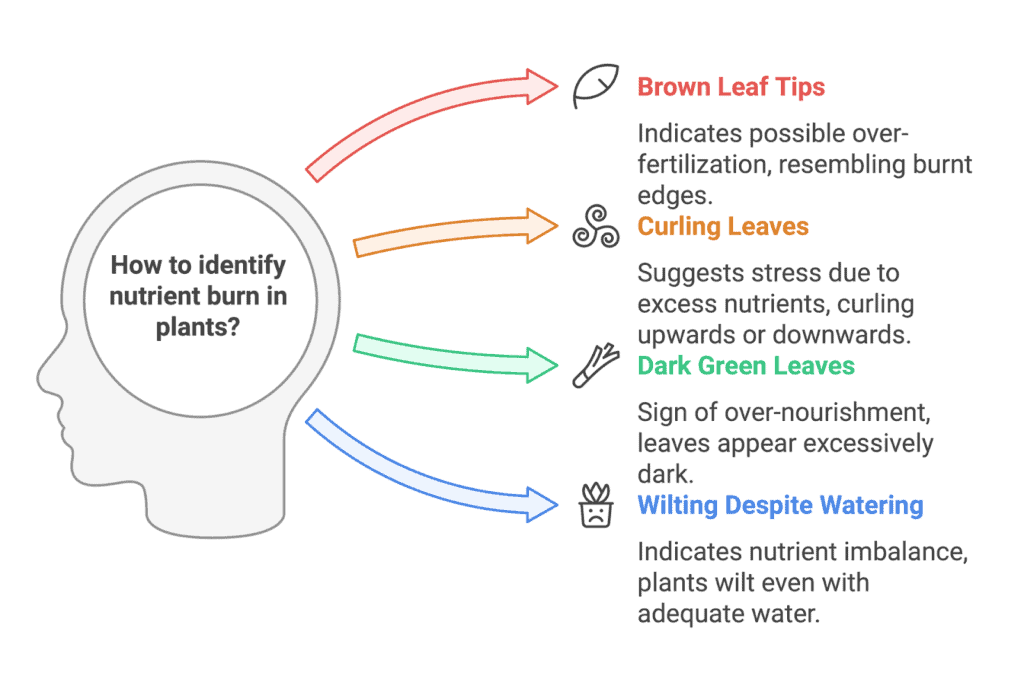
- The browning of the leaf tips is the most obvious indication. They may even look burnt.
- Stress can cause leaves to curl upwards or downwards.
- Overnourished plants may have dark green leaves.
- Affected plants may wilt despite proper watering.
As we said, nutrient burn often results from fertilizer overuse. This can occur when the nutrient mix is too strong or if fertilizers are applied too frequently.
To avoid nutrient burn, check your feeding schedule and nutrient ratios. Keeping cannabis’ pH between 6.0 and 6.5 is also important. Improper pH can hinder nutrient absorption, leading to build-up.
Take action quickly if your plants show nutrient burn symptoms. Water flushing removes excess soil nutrients. Feeding schedule changes might also restore plant health.
Causes of Nutrient Burn

Many variables can induce nutrient burn in cannabis plants. High nutrient levels and poor pH balance are common causes of this problem.
Nutrient Levels and Excess
Overnutrition in the soil can cause nutrient burn. When given too many nutrients, this accumulation can prevent plants from absorbing water. The plant’s failure to absorb moisture yellows or browns leaf tips.
To prevent this, start with lower nutrient levels, especially in the early stages of growth. Be vigilant with your plants. Adjust nutrient amounts per development stage to avoid overfertilization.
Effects of pH
Nutrient uptake depends on growing medium pH. For soil cultivation, cannabis plants need a pH of 6.0–6.5. An overly high or low pH level may make it more difficult for plants to adequately absorb nutrients.
Unbalanced pH can produce nutritional deficiencies or surpluses. Even with a balanced nutrient mix, improper pH can cause nutritional burn. Regular pH measurements are essential. When needed, employ pH-adjusting solutions to keep plants healthy.
Identifying Nutrient Burn Symptoms in Cannabis Plants
Recognizing nutrient burn helps cannabis plants stay healthy. Look out for specific symptoms that indicate this condition. Early detection helps reduce harm in the long term.
Early Nutrient Burns Signs
Nute burn often starts at the leaf tips. They may turn brown or yellow. This is because the plant struggles with too many nutrients. The burn symptoms can progress to browning edges or patches on the leaves.
Other signs of nutrient burn include leaf curl with twisted or clawed leaves. If you see these changes, act immediately.
Check leaf color and shape to diagnose nutritional burn. Regular plant inspections can also spot these signs early.
Prevention and Management of Cannabis Nutrient Burn
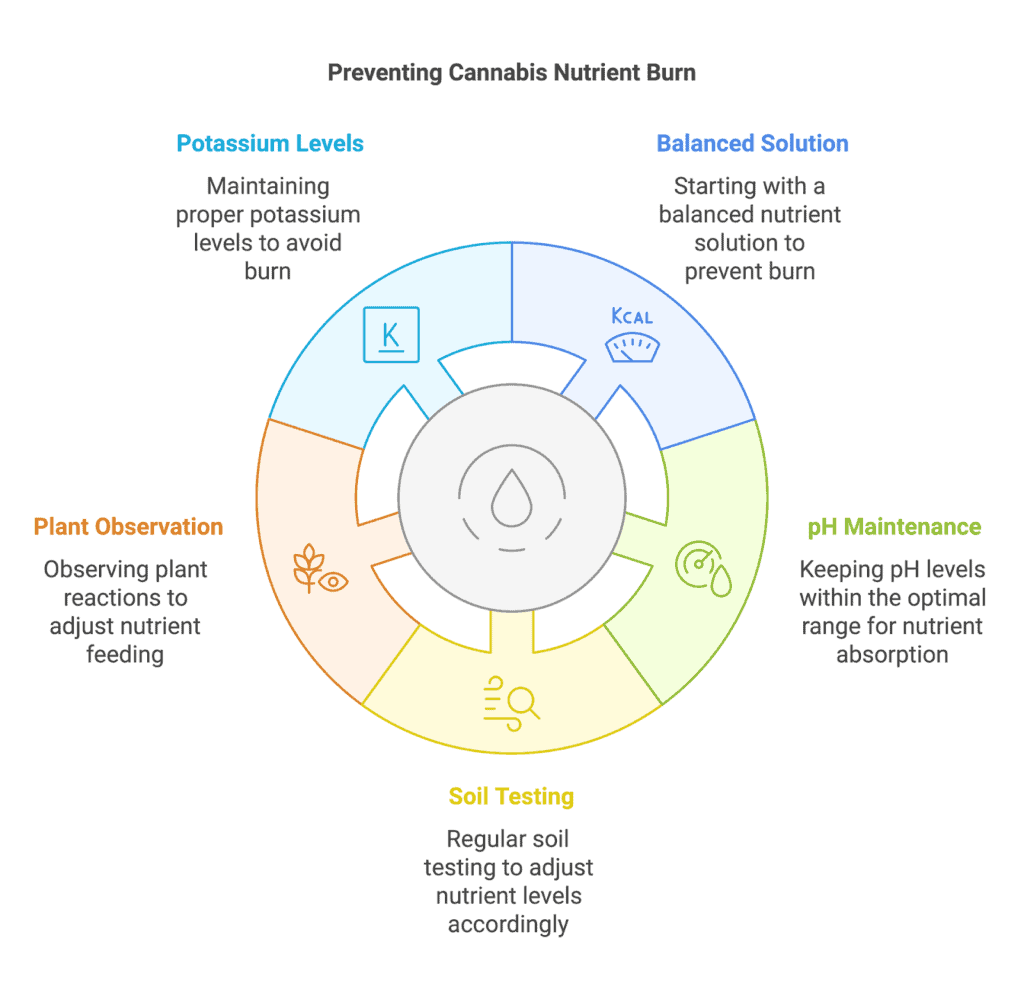
To keep your cannabis plants healthy, controlling nutrient burn is essential. By carefully optimizing your nutrient solution and maintaining proper potassium levels, you can help prevent nutrient burn.
Optimizing Your Nutrient Solution
Start with a balanced nutrition solution to avoid burn. Prior to feeding your plants, it is crucial to assess their nutritional levels.
- Start with reduced concentrations: Use only ¼ to ½ of the fertilizer label’s recommended amount. This lets plants adjust gradually.
- Pay attention to pH: Maintain a pH of 5.5 to 6.5 in the fluid to help plants absorb nutrients and avoid burns.
- Frequent soil testing: To detect nutrient accumulation, test soil regularly. This helps you adjust your nutrient blend.
- Watch your plants: Watch how plants react after feeding. Reduce nutrition concentration immediately if nutrient burn occurs.
Maintaining Proper Potassium Levels
Too much potassium might create nutritional burn, even though it’s essential for cannabis growth.
- Find the right levels: Make sure the soil’s potassium content stays between 1.5 and 3.0%.
- Adjust fertilizer use: Choose balanced potassium fertilizers. Overfertilization can cause nutrients to accumulate and lead to nutrient burns
- Use supplements properly: Be sure to follow potassium supplement instructions carefully. Too much may overwhelm your plants.
- Frequent monitoring: Check your plants for signs of potassium deficiency, like yellowing leaves, to avoid overcompensating.
Correcting Nutrient Burn Issues
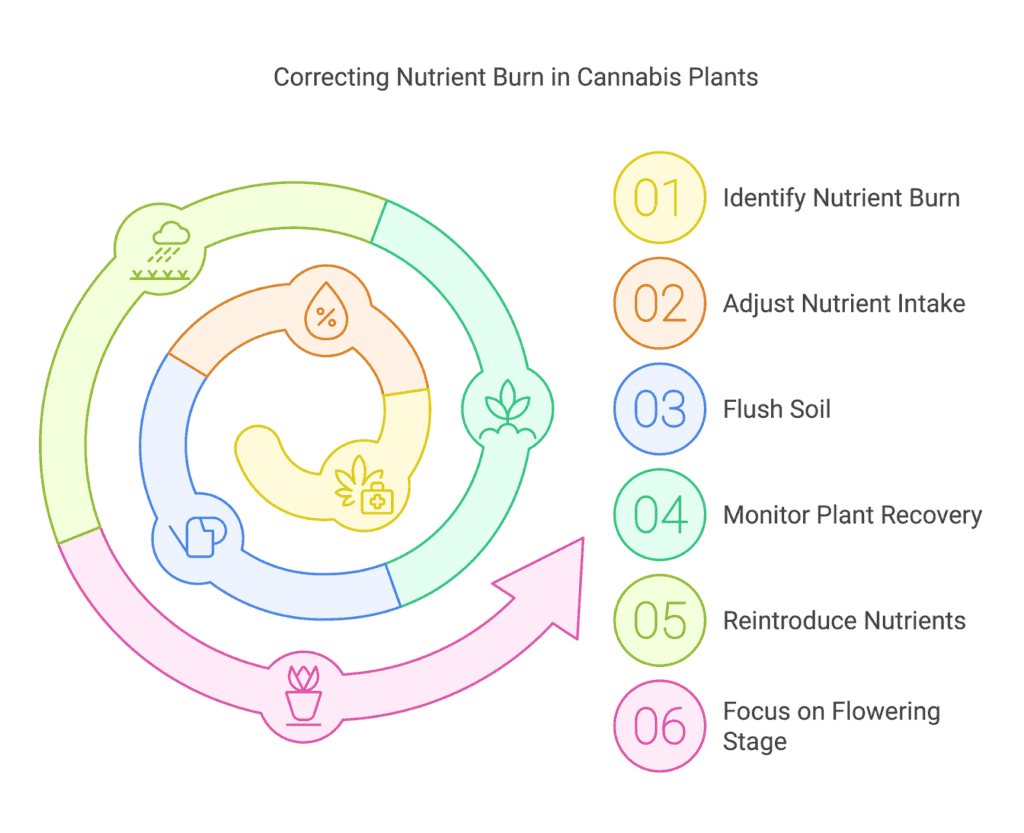
Nutrient burns can stress your cannabis plants significantly. It’s essential to adjust your nutrient intake and provide proper recovery, especially during the flowering stage, to protect your plants and promote healthy growth.
Adjusting Nutrient Intake
Check your nutrition solution first. Reduce nutrient concentration immediately if nutrient burn is suspected. Cutting the nutrient mix in half may reduce plant stress.
Flush soil with pH-balanced water to eliminate nutrients. Use three times the pot’s volume of water. This helps remove nutrient accumulation.
After these changes, monitor your plants. Look for strong growth to signal recovery. Once your plants are stable, gently return nutrients and adapt your feeding schedule.
Recovery During the Flowering Stage
Flowering plants are especially sensitive, so be careful when administering nutrients. Nutrient burn symptoms like crispy or yellow leaf tips require immediate action.
Focus on using a balanced nutrient mix formulated for flowering plants. Avoid bloom boosters until your plants show signs of recovery. Use less often, as these can contribute to nutrient burn if the plants are still struggling.
Provide adequate water to let your plants recuperate. Let the soil dry between waterings. This helps roots grow and get oxygen. While you help your plants recuperate, maintain a stable environment.
Bottom Line
Understanding and managing nutrient burn is essential for maintaining the health and productivity of your cannabis plants. By recognizing early signs, maintaining proper nutrient levels, and taking corrective actions, growers can prevent long-term damage and support robust plant growth. With careful monitoring and adjustments, you can ensure your cannabis thrives and yields its full potential.
Frequently Asked Questions
Can cannabis plants recover from nutrient burn?
Cannabis plants can recover from nutrient burn if detected early and you take the right measures. Many plants recover with proper care and fertilizer modifications, however it may take time.
How does cannabis nutritional burn look?
Nutrient burn causes crispy, yellow, or brown leaf tips. Moderate cases affect only the tips, while severe ones can damage the entire leaf.
How do you fix nutrient burns?
Flushing the soil with water removes excess nutrients and helps with nutrient burn. It also reduces nutrient concentrations in subsequent applications. Carefully monitor your plants as they recuperate.
What nutritional burn symptoms occur first?
Yellowing and browning leaf tips indicate early nutritional burn.
Can potassium deficiency be distinguished from a nutritional burn?
Nutrient burn often affects only the leaf tips, while potassium deficiency shows symptoms such as yellowing between veins and leaf edges curling. The discoloration pattern helps identify the issue.
What precautions are advised to avoid nutritional burn in cannabis?
Start low and increase nutritional content gradually to avoid nutrient burn. Test your soil pH often to keep it in the correct range. Apply fertilizers in accordance with the plant’s growth phase and refrain from overwatering.

